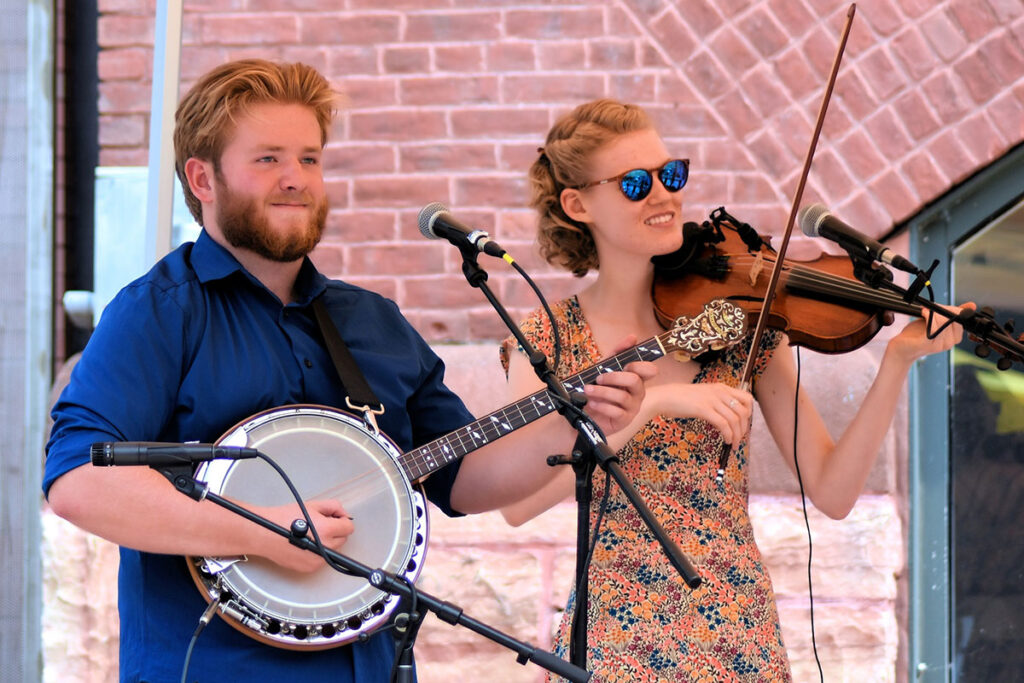Teen Musicians of Sugar in the Pan Find Connection and Community in Traditional Music

The members of Sugar in the Pan play a lot of instruments in a variety of musical styles, but bluegrass on the ukulele was something I didn’t expect.
“I teach at a bluegrass camp up in Alaska. It’s one of my favorite examples of cross-cultural music sharing,” explained Grace Martin. “Every year we have Hawaiians come, and they teach ukulele and Hawaiian songs. We all play songs with each other and at the jams with the instructors, and it’s really cool to see the Hawaiians playing bluegrass on their ukuleles and then us playing Hawaiian lullabies on our banjos.”
At nineteen years old, Martin is one of the oldest members of Sugar in the Pan. The six-member band grew out of the Young Tradition Vermont (YTV) Touring Group at Vermont Folklife, an education and cultural research nonprofit that works to document, nurture, and present community-based expressions including traditional music genres. The Touring Group is a program for teenage musicians, who rehearse from September to April leading up to an annual cultural tour to another region; tours in the past have taken them to Quebec, Scotland, and Japan.
Sugar in the Pan, which will bring its wide repertoire of traditional music to Washington, D.C., for the 2025 Smithsonian Folklife Festival, is made up of musicians who are either currently in or recent alumni of the Touring Group. Both Sugar in the Pan and the Touring Group are dedicated to nurturing young people who are engaged with traditional music.
“When we’re on tour, we are meeting with tradition bearers, taking workshops from tradition bearers and really incredible artists,” said YTV director Ian Drury. “Often [the band] will be playing one of their songs as a part of the Touring Group performance, as a part of our set. And even if we haven’t worked with them, they’ll see a recording of it, and I’ll get feedback of just how powerful it is to see this younger generation playing one of the songs that they wrote.”
The members of the band, along with Drury and Christina Read Kennedy, director of the Touring Group, joined me on Zoom—in the evening, of course, since most of them are in school during the day—to talk about what makes a group of young people so excited about old music.
In addition to Martin, the group is made up of five other musicians ranging from ages fourteen to nineteen. Most of them play multiple instruments, and all of them sing. Although they are young, they have all been playing music for years already. Their enthusiasm for, dedication to, and fresh takes on traditional music make them a perfect fit for this year’s Folklife Festival theme, Youth and the Future of Culture.
Fiddle player Fiona Stowell, nineteen, has been participating in YTV programs for young musicians since she was about seven years old, starting with the Fiddleheads program, for beginner musicians, and then Trad Camp, a week-long traditional music-focused summer camp for youth aged nine to eighteen. For her, joining the Touring Group and then Sugar in the Pan felt like the “natural next step.” Growing up seeing YTV performances was a big inspiration for her.
“The first time I saw them play with my parents, I was like, ‘Oh my god, I want to do that. I want to get good enough to do that,’” she said. “Touring was super exciting sounding to me and really drew me to it, and having a community of other young people that like doing what I do sounded really great.”

Her brother Emmett Stowell, sixteen, plays the piano and the five-string banjo in the band—instruments he’s been playing for about nine and eleven years, respectively. He followed a similar path, participating in YTV programs and watching the performances from a young age. The two siblings play a lot of music together, he said, but they also have a great appreciation for their wider community of traditional musicians.
Eli Glasser, fourteen, grew up in California and started playing classical violin and piano when he was seven years old. He first heard traditional music at a fair and started playing Texas-style and old-time folk music at fiddle contests before moving to Vermont, where he and his brother discovered YTV. He joined our interview by phone from the car, en route to Amherst as he toured colleges in Massachusetts with his family.
“My brother joined [first] because he’s a year older than me,” Glasser said. “I listened to their concerts, and I thought it was really amazing, so I joined the group the [first] year that I could, the next year.”
Some of the band members, like fiddler Henry Kervick, fourteen, have a familial connection to certain styles of music. He grew up with the Suzuki method before trying YTV programming such as Fiddleheads and Trad Camp at the suggestion of his fiddle mentor, Romy Munkres. He has Swedish ancestry on his father’s side.
“That is part of the reason that I play a lot of Swedish [traditional music],” he said. “It’s really fun. The rhythm is usually a lot different than the music that we play around here and how you feel it.”


Martin’s Irish heritage comes from her mother’s side, but she grew up playing Irish traditional music with her father. The music was popular with sailors on the Maine coast, she explained, which is where her dad found musical mentors as a young sailor and musician. Martin started playing classical piano around age five, but her father “has always been playing fiddle music and accordion around the house since I was little,” she said.
“I kind of just grew up with that always present in my life, even if it wasn’t what I was doing musically,” she continued. “So when I was older, we moved and I started learning guitar, and I started jamming with my dad a lot. He would play the fiddle, and we’d play Irish tunes together in the kitchen. I just fell in love with it even more, so when I got the chance to join the Touring Group, I was super psyched. That led me down a big rabbit hole of traditional music that I’m really happy to be in.”
For Owen Kennedy, nineteen, his mother, Christina Read Kennedy, got him involved with music early in life.
“[My mom] grew up learning through the Suzuki method, classical violin, and she knew that when she had kids, she wanted hers to as well,” he explained. He started playing violin with the Suzuki method at four years old, joined a fiddle group at age seven, and added mandolin, banjo, shruti box, and stomp box over the years. In 2019, he attended the Young Tradition Festival in Burlington and saw the touring group perform. “Pete Sutherland sat down right next to me and was like, ‘You should go play up on stage with them.’ I was like, ‘Yep, that sounds like a lot of fun!’”
Kennedy has both Scottish and Irish family and is particularly passionate about Scottish music: “It’s been a lot of fun to learn more about my history and the music that went around my culture.”
“Made his grandparents very proud to see him in the Kennedy kilt, in the Kennedy plaid,” Christina added with a smile.

Traditional music—as YTV defines it, music developed through oral tradition that often has strong ties to a specific culture and place—often emphasizes participation more than performance. It has a function beyond the music itself, whether as a method of passing along stories and histories or as the foundation of cultural events, like social dances. The members of Sugar in the Pan love playing in places where they can feel that connection between the music and the people, especially when the audience can get involved.
“Playing for a dance is really fun because you can facilitate this connection between you and the dancers, and the dancers and each other, and the caller,” Emmett Stowell said. “I think that is a really great place for connection because historically that has been a way of socializing in these rural communities. I think it’s kind of cool that we’re carrying on that tradition.”
One of his favorite places to play is the Brownington Ceilidh Club, a small venue in northeastern Vermont. “It’s in the middle of nowhere, but somehow they still get a good crowd to come in and see the shows. That’s always really fun because it feels like a little party with a bunch of friends. It’s very intimate—the chairs are set up, like, five feet from where you’re playing. I enjoy venues like that the most just because of that very tangible connection.”
Kervick echoed this sentiment. “The concert that we had in Burlington, with the Touring Group, there was a little group of people getting up and dancing in the back. That was really awesome.”
Performing traditional music, they also get to witness the personal and cultural connections people have to the songs. Kennedy recalled playing a traditional Gaelic tune while the touring group was in Cape Breton, Nova Scotia, which has a large population of Scottish and Irish descent, including some people who still speak a Canadian dialect of Scottish Gaelic. The group learned the song, “O, Teannaibh Dlùth is Togaibh Fonn (Now Draw Up Close and Sing a Song),” from Celtic artist Dominique Dodge specifically for the tour.
“Pretty much every time that we performed it, whether it was at a dance hall or a retirement community or some other performance space, people would be crying because they remembered getting sung that lullaby when they were a baby or a little kid,” Kennedy said. “It really brought them back. Being able to connect with those people in that way was really special.”
Passed from generation to generation, traditional music naturally evolves, shaped by each new musician who plays it. While they each bring their own cultural and musical backgrounds to the band, these young musicians don’t limit themselves to learning one style of traditional music.
“A fun thing that we have as young trad musicians is the ability to connect styles and be creative with our genre bending, while still hopefully trying to stay true to the tradition,” Emmett Stowell said. “Which I think is a balance, but I have a lot of fun mixing and matching and combining. Fiona once did a Scottish march in the style of an old-time tune. A lot of fun opportunities happen there.”
Kennedy added, “Learning different styles—I’ve always found this really interesting—is like trying to figure out how we can think of them as a cap, and put on an old-time cap or a Scottish cap or an Irish cap.” After moving to Cape Breton for college two years ago, he was struck by how the traditional music there—developed in more isolated immigrant communities—differs from traditional Scottish music. “Whether it’s ornamentation or bowing or any of those things, [I like] figuring out what the similarities are, what the differences are, how they’ve been influenced.”

The Smithsonian Folklife Festival is going to be yet another opportunity for these young musicians to hear new music and meet musicians from a variety of cultures.
“I know we’re going to be jamming with people who play vastly different music than us,” Martin said. A history major (and self-described “huge history geek”), she is looking forward to being on the National Mall. “All the people walking by are going to be just such different combinations of people, and I’m really excited for us to be able to share our music with them.”
Drury shares their excitement: “I’m really thrilled that this group of wonderful young people are going to have this opportunity to be able to play with so many different artists down there and to be able not only share their incredible talents, but be able to soak in everything that’s going to be at the Festival.”
With a few months until the Festival, the band still has plenty of time to prepare—and even learn new repertoire. Martin told me about two of her current favorite songs to play, “Sweet Nell,” an old-time fiddle tune, and “Red Prairie Dawn,” a traditional Irish reel, both of which she learned recently after hearing them at a jam in Maine. Two fun, upbeat tunes, they are popular in the traditional music scene right now.
“You can think of us on Thursday,” Christina Read Kennedy said. She would be driving with her son and Martin from Maine to Vermont to meet at the Stowell home for a rehearsal. “I 100 percent guarantee you that I will hear ‘Sweet Nell’ and ‘Red Prairie Dawn.’ I drive, they play and sing and play and sing.”
“On dueling mandolins, mind you,” Fiona Stowell cut in. “Emphasis on the dueling mandolins.”
“Very easily handheld, back in the car, just picking,” Martin laughed.
Sugar in the Pan will perform daily at the 2025 Smithsonian Folklife Festival, which takes place July 2–7 in Washington, D.C.

Rebecca L. West is a digital public history intern at the Center for Folklife and Cultural Heritage and a graduate student at George Mason University.




